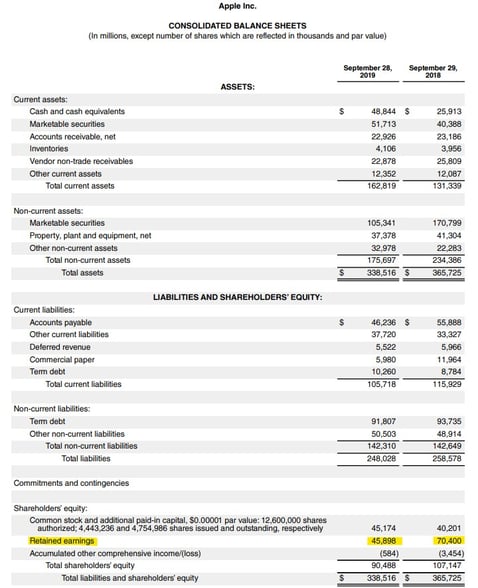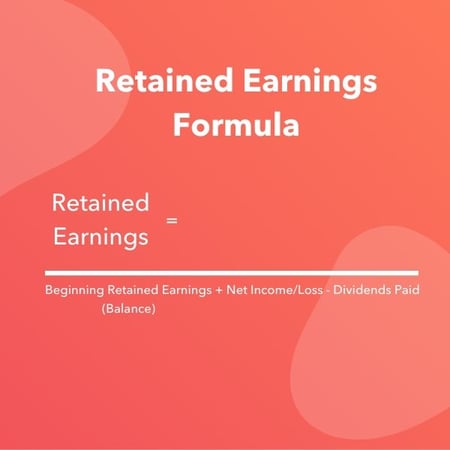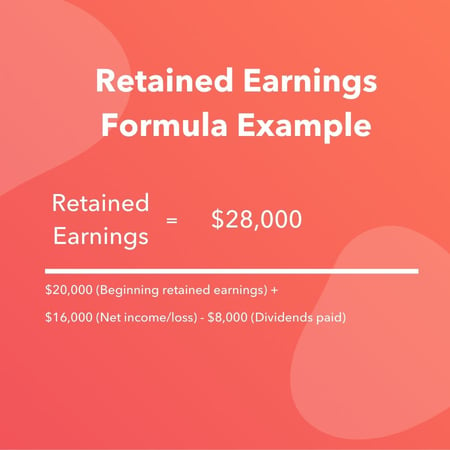Once your business begins to earn a profit, you'll need to reinvest some of those earnings. This will help your business grow and gain more profit. Any additional funds that aren't distributed to shareholders and investors are referred to as retained earnings.

What can you do with these leftover funds? Businesses often reinvest in things like new equipment, repaying debt, product development, or marketing.
Next, we'll learn about the importance of retained earnings and how to calculate it.
Retained Earnings
Retained earnings are the part of a business' profit that's reinvested in the business, rather than being distributed to investors and shareholders as dividends. They are reported on the balance sheet for each accounting period.
The leftover funds from a business' profit that aren't given to investors and shareholders are known as retained earnings. And these funds are often reinvested into the business.
The retained earnings amount can be found on the balance sheet below the shareholders' equity section. The earnings are reported at the end of each accounting period, which is typically 12 months long. Below is an example balance sheet for Apple that highlights retained earnings.

Source: Apple
So, why are retained earnings important? They can be invested in the business or fund growth opportunities like working capital or acquiring other businesses. Other common uses for these earnings include:
- Repaying business loan debt
- Paying additional dividends to investors
- Investing in marketing
- Upgrading existing capital assets such as equipment
- Investing in new capital assets such as CRM software or a new website
- Funding for research and development
- Investing in new offerings or target markets
- Holding it in reserve for potential future losses or economic downturn
The goal of reinvesting this additional profit is to grow your business and increase earnings over time. But, if the business doesn't believe it can make a satisfactory return on investment from the retained earnings, it can choose to distribute the earnings to shareholders.
How to Calculate Retained Earnings
Retained earnings are calculated by starting with the previous accounting period's retained earnings balance, adding the net income or loss, and subtracting dividends paid to shareholders.
With the retained earnings formula, we can see how much money a business has to reinvest. Let's see how the formula can be used to calculate the final retained earnings amount that's listed on the balance sheet.
Retained Earnings Formula
Retained earnings are calculated with the following formula:

Next, we'll take a look at the elements that make up the retained earnings formula.
Beginning Retained Earnings
The beginning retained earnings are the retained earnings from the previous accounting period. This number can be positive or negative. For example, if the dividends paid are greater than the beginning retained earnings balance, the resulting number would be negative. A negative retained earnings amount can also occur if the business had a significant loss in net income.
Net Income
Net income is a business' profit minus the cost of goods sold, taxes, and expenses for the current accounting period. This number will be positive if the business made a profit, and negative if it suffered a loss.
Dividends Paid
Dividends paid is the total amount of a business' earnings that are distributed to shareholders and investors. This number includes both cash and stock dividends.
Retained Earnings Example
It's time to see the retained earnings formula in action, using Becca's Gluten-Free Bakery as an example. Becca's Gluten-Free Bakery has steadily been growing in business due to her location downtown. However, because she's a startup with a brand-new product, she's concerned about overdrawing from her revenue and not being able to invest more into innovation that will keep people coming back.
At the beginning of the quarter, she had $20,000 on her balance sheet and decided to launch a new line of gluten-free brownies. The cost of developing the new product was a concern, but due to the excitement generated by these awesome brownies, she managed to make $16,000 after the cost of goods sold, which can be added as net new income.
Becca is energized by the success of her brownies (and even her staple products that sold as a result). She has a ton more ideas that she thinks will have a similar effect on her target market. So the question is: How does Becca know if she's doing well or not? How can she determine if she can afford another new line of product to keep this cookie craze going? Will she have enough to pay the $8,000 in dividends to her investors?
In this scenario, we know that the business has the following numbers for the current period:
- Beginning retained earnings: $20,000
- Net income/loss: $16,000
- Dividends paid: $8,000
Retained earnings are calculated by plugging these numbers into the formula:

Becca's Gluten-Free Bakery has retained earnings of $28,000 for the current period, which is $8,000 more than the previous period. Becca could reinvest this money in her business by purchasing another mixer, investing in new marketing software to better announce future product launches, getting a new website design, or paying off the rest of the business' debt.
Reinvesting a portion of your profit is key to growing your business, and retained earnings provide you with the funds to reinvest. Need some additional help with your business' accounting? Check out the best free and paid accounting software options next.

